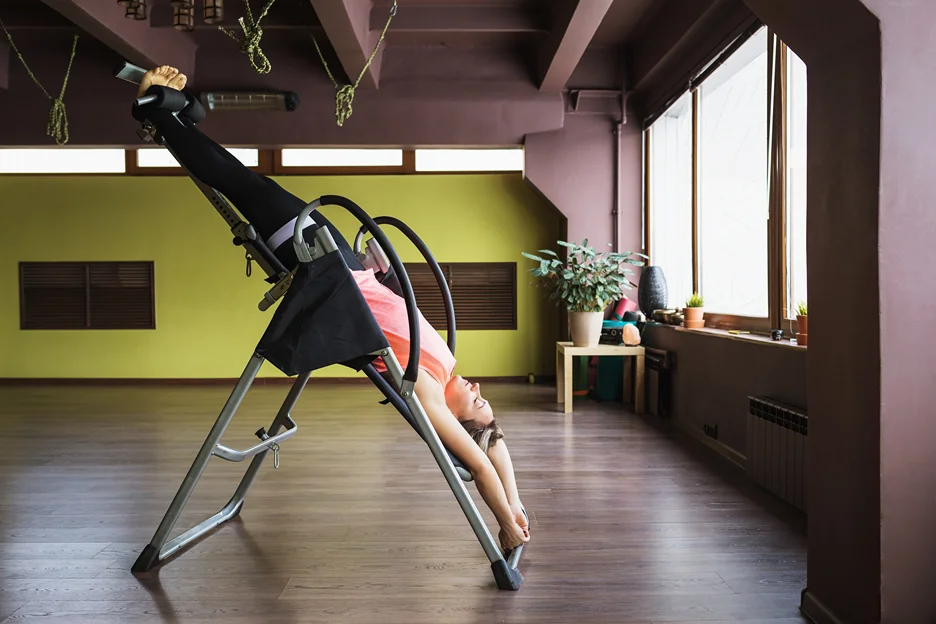Living with chronic back pain is miserable. It makes everyday activities like sitting, bending, or lifting a struggle.
You seek relief through medications, physical therapy, massage—anything to stop the constant aching. What if simply hanging upside down could decompress your spine, relax your muscles, and provide sweet relief?
While it may sound counterintuitive, inversion therapy is growing in popularity as an effective drug-free treatment for many back conditions.
Let’s explore the mechanics, benefits, and proper use of inversion tables to relieve your back pain.
What is an inversion therapy table?
An inversion table is a device that allows you to invert your body into an upside down position to achieve spinal traction and decompression. It looks much like a regular table that can tilt to an inverted angle with adjustable padded backrests and pivot points.
The user secures their ankles in ankle locks and slowly shifts into an inverted position, allowing gravity to provide gentle traction along the length of the spine. This decompresses the vertebrae and relieves pressure on discs, joints, ligaments and muscles.
Teeter, Ironman, and Innova are popular brands of inversion tables for home use.
How does an inversion table work?
Using an inversion table is simple. Here’s a quick step-by-step walkthrough:
Adjust the settings
- Set the height of the inversion table according to your height
- Adjust the ankle locks to fit your ankles securely
- Set the desired inversion angle, starting low as a beginner (20-30 degrees)
Get settled on the table
- Secure your ankles in the ankle locks
- Place your arms on the support handles for stability
Invert slowly
- Shift your body weight towards your head using the support handles
- This will rotate the table to invert your body upside down
- Invert slowly to the set inversion angle
Remain inverted
- Hold the inverted position for 2-3 minutes as your muscles relax
- Allow your spine to decompress as your body weight provides traction
Return upright
- Use the support handles to slowly return your body to the upright position
- Take breaks between sets to allow your circulation to stabilize
Repeat
- Complete 2-3 sets per inversion therapy session
- Gradually increase inversion time and angle as you get accustomed to the stretches
Finish session
- Make sure to decompress your spine after final set
- Unlock ankles and dismount table when complete
What are the benefits of inversion therapy?

One study found a significant improvement in back pain symptoms after regular inversion therapy sessions.
The spinal realignment also improves posture by reducing spinal curvature. Inverting also enhances circulation and oxygen flow to the brain to relieve mental fatigue and stress. Other benefits include:
- Increases flexibility by stretching tight hamstrings, hip flexors, and back muscles
- Hydrates and decompresses spinal discs to reduce complaints of a stiff, inflexible back
- Creates negative intradiscal pressure to allow disc rehydration and healing
- Widens the spinal canal allowing nerves more room to exit the vertebral foramen
- Helps relieve pinched nerves, compressed facet joints, and muscle spasms
- Improves the flow of spinal fluid and drainage of lymph for healing
Why does an inversion table hurt my lower back?
As a beginner, using an inversion table too aggressively can put strain on your lower back. Inverting too far or quickly can overstretch muscles or place pressure on pre-existing disc injuries.
Key tips are to start slowly, adjust the lumbar support to maintain your back’s natural curve, and limit inversion angles as a new user.
Obesity or spinal fusion surgery can also affect your ability to benefit from inversion therapy.
Remember to allow your body to become accustomed to regular use. Most discomfort diminishes once the back muscles become more flexible and strong.
Can an inversion table solve back problems?
While extremely beneficial for relief, inversion therapy itself does not cure medical back conditions or replace medical treatment. It should be used as a complementary therapy along with proper rest, medications, and targeted back exercises recommended by your physician.
Inversion helps alleviate chronic symptoms but further treatment may be needed to fully resolve conditions like degenerative disc disease, spinal stenosis or scoliosis.
Those with fractures, weak bones, high blood pressure, or other contraindicated conditions should consult a doctor before considering inversion therapy.
Does an inversion table really work?
A review found inversion therapy effective in reducing nerve root compression, providing long-term pain relief for sciatica patients. By allowing gravity to decompress the spine and stretch muscles using your own body weight, it provides spinal traction not possible through normal activity. This mobilizes stiff joints that regular exercise cannot reach.
Does inversion table therapy work for sciatica?
Stretching the hamstrings and piriformis muscles while inverted also alleviates sciatic tension. Spinal traction through inversion helps rehydrate the herniated discs so they stop pressing on nerve roots. While not a standalone sciatica cure, inversion therapy can provide significant pain relief when used along with other treatments.
What is an inversion back stretcher?
An inversion back stretcher refers to an inversion table optimized for stretching and elongating the back. While regular inversion tables aim to decompress the full spine, a back stretcher has a softer, flexible backrest to really isolate and stretch the paraspinal muscles.
Some allow incremental adjustments so you can find just the right amount of traction for your back flexibility. Back stretcher models like the Teeter EZ Stretch have split front legs for unhindered inverting mobility. This lets you sink into a full inversion safely for an intense back stretch.
Does an inversion table help with neck pain?
While focusing on the back, inverting upside down also decompresses the neck to address cervical spine issues. As gravity gently pulls, it stretches tight neck muscles often contributing to headaches and upper back pain.
Proper form is important to limit pressure on the delicate cervical vertebrae. Adjust cervical support and avoid over-arching the neck which can aggravate symptoms.
What is a traction table for back?
Inversion therapy tables designed specifically for back traction allow incremental stretching all along your spine’s axis. Adjustable handles or bars let you control the intensity of the traction pull while inverted. Your doctor may recommend lumbar traction first to target a disc herniation before moving up the back slowly.
Can an inversion table help degenerative disc disease?
Although it does not reverse or cure disc degeneration itself, by relieving pressure it can make everyday back movements less painful. Inversion alleviates related back stiffness by gently mobilizing the spine in ways not possible through exercise alone. For those with advanced degenerative disc disease, consult a physician about the appropriateness of using inversion therapy.
What are some inversion table sciatica exercises?
To enhance sciatica pain relief from inversion therapy, certain exercises when upside down can provide further benefits:
| Exercise | Description |
| Hamstring stretches | Bend and extend legs while inverted to stretch hamstrings |
| Piriformis stretch | Externally rotate hips while inverted to target piriformis muscle |
| Lower back extensions | Raise arms or legs while inverted to extend lower back |
| Pelvic tilts | Rock hips forward and backward to mobilize pelvis |
Tips for inversion table sciatica exercises:
- Go slowly, focus on alignment and form
- Do not overstretch
- Inversion already stretches sciatica-related muscles
- Light exercises help target problem areas
- Provide complete sciatica relief
How Inversion Therapy Can Relieve Your Back Pain

If you’re one of the millions of adults suffering from chronic back pain, we understand the daily frustration and struggle you face. The aching soreness, stiffness, and loss of mobility can make even simple tasks unbearable. You’ve tried medications, heating pads, special pillows – but true relief remains elusive.
At Kaly, we’re on a mission to empower back pain warriors like you. We know there’s a better way – a drug-free, customizable therapy that can decompress your spine, relax your muscles, and get you moving comfortably again. We’re talking about inversion therapy using an inversion table.
We always recommend consulting with a physician before trying inversion therapy, especially if you have any medical conditions or contraindications. The back specialists in our Kaly network are happy to advise whether inversion may be helpful for your specific back issues. They can also guide you on proper use of inversion tables to avoid injury.
